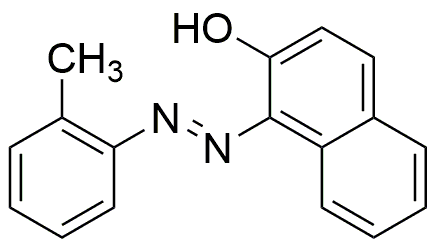Oil orange SS is widely utilized in research focused on:
- Food Industry: This compound serves as a colorant in various food products, enhancing visual appeal while adhering to safety regulations.
- Textile Industry: It is used as a dye for fabrics, providing vibrant colors that are resistant to fading, making it ideal for clothing and upholstery.
- Biological Staining: In laboratories, Oil orange SS is employed as a staining agent for lipid detection in biological samples, aiding researchers in visualizing cellular structures.
- Cosmetics: The chemical is incorporated into cosmetic formulations to impart color, ensuring products are visually attractive while being safe for skin application.
- Research and Development: It is often used in various scientific studies to investigate dye behavior and stability, contributing to advancements in material science.
General Information
Properties
Safety and Regulations
Applications
Oil orange SS is widely utilized in research focused on:
- Food Industry: This compound serves as a colorant in various food products, enhancing visual appeal while adhering to safety regulations.
- Textile Industry: It is used as a dye for fabrics, providing vibrant colors that are resistant to fading, making it ideal for clothing and upholstery.
- Biological Staining: In laboratories, Oil orange SS is employed as a staining agent for lipid detection in biological samples, aiding researchers in visualizing cellular structures.
- Cosmetics: The chemical is incorporated into cosmetic formulations to impart color, ensuring products are visually attractive while being safe for skin application.
- Research and Development: It is often used in various scientific studies to investigate dye behavior and stability, contributing to advancements in material science.
Documents
Safety Data Sheets (SDS)
The SDS provides comprehensive safety information on handling, storage, and disposal of the product.
Product Specification (PS)
The PS provides a comprehensive breakdown of the product’s properties, including chemical composition, physical state, purity, and storage requirements. It also details acceptable quality ranges and the product's intended applications.
Certificates of Analysis (COA)
Search for Certificates of Analysis (COA) by entering the products Lot Number. Lot and Batch Numbers can be found on a product’s label following the words ‘Lot’ or ‘Batch’.
*Catalog Number
*Lot Number
Certificates Of Origin (COO)
This COO confirms the country where the product was manufactured, and also details the materials and components used in it and whether it is derived from natural, synthetic, or other specific sources. This certificate may be required for customs, trade, and regulatory compliance.
*Catalog Number
*Lot Number
Safety Data Sheets (SDS)
The SDS provides comprehensive safety information on handling, storage, and disposal of the product.
DownloadProduct Specification (PS)
The PS provides a comprehensive breakdown of the product’s properties, including chemical composition, physical state, purity, and storage requirements. It also details acceptable quality ranges and the product's intended applications.
DownloadCertificates of Analysis (COA)
Search for Certificates of Analysis (COA) by entering the products Lot Number. Lot and Batch Numbers can be found on a product’s label following the words ‘Lot’ or ‘Batch’.
*Catalog Number
*Lot Number
Certificates Of Origin (COO)
This COO confirms the country where the product was manufactured, and also details the materials and components used in it and whether it is derived from natural, synthetic, or other specific sources. This certificate may be required for customs, trade, and regulatory compliance.


